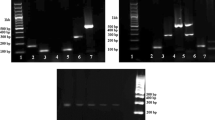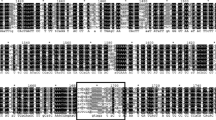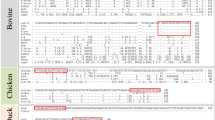Abstract
The traceability of meat origin has become a necessity to safeguard consumer's confidence in commercial meat products. Our study recommends a meat species detection using qualitative approach based on PCR–RFLP and species-specific primers PCR. Here, we targeted a 359 bp fragment of the mitochondrial cytochrome b gene amplified by PCR using universal primers followed by three enzymatic digestions. Seven animal species including dromedary, rabbit, goat, turkey, rat, donkey and pork, have been efficiently detected in pure and mixed samples. The combination of PCR–RFLP and triplex PCR assays offers, in addition, the identification of chicken, dog and cat species in meat. In conclusion, by the mean of PCR-based techniques using universal primers followed by enzymatic digestion and multiplex primer-specific approach, we developed an extensible protocol by which we identified 10 animal species that could be integrated in meat analysis daily routine.




Similar content being viewed by others
Data availability
All data analyzed during this study are included in this published article (and its supplementary information files).
Abbreviations
- DNA:
-
Deoxyribonucleic acid
- mtDNA:
-
Mitochondrial deoxyribonucleic acid
- MSA:
-
Multiple sequence alignment
- PCR:
-
Polymerase chain reaction
- PCR–RFLP:
-
Restriction fragment length polymorphism polymerase chain reaction
- PCR-SSCP:
-
Single-strand conformation polymorphism polymerase chain reaction
- EDTA:
-
Ethylenediaminetetraacetic acid
- D-loop:
-
Displacement loop
- MgCl2 :
-
Magnesium chloride
- dNTP:
-
Deoxynucleotide
- DMSO:
-
Dimethyl sulfoxide
- Cyt b:
-
Cytochrome b
- CaSSR:
-
Cat species-specific region
- DoSSR:
-
Dog species-specific region
- NEBcutter:
-
NEB—New England Biolabs cutter
References
Wu H, Qian C, Wang R, Wu C, Wang Z, Wang L, Zhang M, Ye Z, Zhang F, He J-S, Wu J (2020) Identification of pork in raw meat or cooked meatballs within 20 min using rapid PCR coupled with visual detection. Food Control 109:106905
Kang T-S (2019) Basic principles for developing real-time PCR methods used in food analysis: a review. Trends Food Sci Technol 91:574–585
Song Q, Chen Y, Zhao L, Ouyang H, Song J (2019) Monitoring of sausage products sold in Sichuan Province, China: a first comprehensive report on meat species’ authenticity determination. Sci Rep 9:1–9
Drupad KT, Katherine AH, Nicholas JWR, Holli W, Dakshat KT, Joseph G, David IE, Royston G (2016) Meat, the metabolites: an integrated metabolite profiling and lipidomics approach for the detection of the adulteration of beef with pork. Analyst 141:2155
Ahmed N, Sangale D, Tiknaik A, Prakash B, Hange R, Sanil R, Khan S, Khedkar G (2018) Authentication of origin of meat species processed under various Indian culinary procedures using DNA barcoding. Food Control 90:259–265
Hossain MM, Uddin SMK, Sultana S, Wahab YA, Sagadevan S, Johan MR, Ali ME (2020) Authentication of Halal and Kosher meat and meat products: Analytical approaches, current progresses and future prospects. Crit Rev Food Sci Nutr 1–26
Li Y-C, Liu S-Y, Meng F-B, Liu D-Y, Zhang Y, Wang W, Zhang J-M (2020) Comparative review and the recent progress in detection technologies of meat product adulteration. CRFSFS 19:2256–2296
Ross A, Brunius C, Chevallier O, Dervilly G, Elliott C, Guitton Y, Prenni JE, Savolainen O, Hemeryck L, Vidkjaer NH, Scollan N, Stead SL, Zhang R, Scollan N (2020) Making complex measurements of meat composition fast: Application of rapid evaporative ionisation mass spectrometry to measuring meat quality and fraud. Meat Sci 108333
Abbots E-J, Coles B (2013) Horsemeat-gate: the discursive production of a neoliberal food scandal. Food Cult Soc 16:535–550
Nau J-Y (2013) Horse meat: first lessons of a scandal. Rev Med Suisse 9:532
Hsieh Y-H-P, Ofori J-A (2014) Detection of horse meat contamination in raw and heat-processed meat products. J Agric Food Chem 62:12536–12544
Kane D (2015) Identification of species in ground meat products sold on the U.S. commercial market using DNA-based methods. Master's thesis, Chapman University
Qiuchi S, Yiwu C, Liming Z, Hongsheng O, Jun S (2019) Monitoring of sausage products sold in Sichuan Province, China: a first comprehensive report on meat species’ authenticity determination. Sci Rep 9:1
Abbas O, Zadravec M, Baeten V, Mikuš T, Lešić T, Vulić A, Prpić J, Jemeršić L, Pleadin J (2018) Analytical methods used for the authentication of food of animal origin. Food Chem 246:6–17
Cavin C, Cotteneta G, Kevin M-C, Pascal Z (2018) Meat vulnerabilities to economic food adulteration require new analytical solutions. Food AnAlysis MeAt And MeAt Prod 72:697–703
Gargouri H, HadjKacem H (2018) Evaluation of alternative DNA extraction protocols for the species determination in turkey salami authentication tests. Int J Food Prop 21:733
Alikord M, Momtaz H, Keramat J, Kadivar M, Homayouni RA (2017) Species identification and animal authentication in meat products: a review. Food Measure 12:145
Kaltenbrunner M, Hochegger R, Cichna-Markl M (2018) Development and validation of a fallow deer (Dama dama)- specific TaqMan real-time PCR assay for the detection of food adulteration. Food Chem 243:82–90
Liu W, Tao J, Xue M, JiJ ZY, Zhang L, Sun W (2019) A multiplex PCR method mediated by universal primers for the identification of eight meat ingredients in food products. Eur Food Res Tech 245:2385–2392
Lo Y-T, Shaw P-C (2018) DNA-based techniques for authentication of processed food and food supplements. Food Chem 240:767–774
Hang J, Sejeong K, Jeeyeon L, Soomin L, Heeyoung L, Yukyung C, Hyemin O, Yohan Y (2017) Identification of pork adulteration in processed meat products using the developed mitochondrial DNA-based primers. Korean J Food Sci Anim Resour 37:464–468
Guan F, Jin Y, Zhao J, XU A, Luo Y (2018) A PCR method that can be further developed into PCR-RFLP assay for eight animal species identification. J Anal Methods Chem 5890140
Jonker KM, Tilburg JJHC, Hägele GH, de Boer E (2008) Species identification in meat products using real-time PCR. Food Addit Contam Part A 25:527–533
Thienes Ha Y, Agapov CP, Laznicka AA, Han AV, Nadala S, Samadpour MC (2018) Comparison of ELISA and DNA lateral flow assays for detection of pork, horse, beef, chicken, turkey, and goat contamination in meat products. J AOAC Int 102:189–195
Li XN, Guan YF (2019) Specific identification of the adulterated components in beef or mutton meats using multiplex PCR. J AOAC Int 102:1181–1185
Liu WW, Tao J, Xue M, Ji JG, Zhang YH, Zhang LJ, Sun WP (2019) A multiplex PCR method mediated by universal primers for the identification of eight meat ingredients in food products. Eur Food Res Tech 245:2385–2392
Naaum A, Shehata H, Chen S, Li J, Tabujara N, Awmack D, Hanner R (2018) Complementary molecular methods detect undeclared species in sausage products at retail markets in Canada. Food Control 84:339–344
Doosti A, Dehkordi PG, Rahim E (2014) Molecular assay to fraud identification of meat products. J Food Sci Technol 51:148–152
Kumar A, Rajiv R-K, Brahm D-S, Palanisamy G, Sanjod K-M, Deepak S (2015) Identification of species origin of meat and meat products on the DNA basis: a review. Crit Rev Food Sci Nutr 55:1340–1351
Shabani H, Mehdizadeh M, Mousavi S-M, Dezfouli E-A, Solgi T, Khodaverdi M, Rabiei M, Rastegar H, Alebouyeh M (2015) Halal authenticity of gelatin using species-specific PCR. Food Chem 184:203–206
Amorim A, Fernandes T, Taveira N (2019) Mitochondrial DNA in human identification: a review. PeerJ 7:7314
Floren C, Wiedemann I, Brening B, Schutz E, Beck J (2015) Species identification and quantification in meat and meat products using droplet digital PCR (ddPCR). Food Chem 173:1054–1058
Mane B-G, Mendiratta S-K, Tiwari A-K (2009) Polymerase chain reaction assay for identification of chicken in meat and meat products. Food Chem 116:806–810
Kocher T-D, Thomas W-K, Meyer A, Edwards S-V, Paabo S, Villablanca F-X (1989) Dynamics of mitochondrial DNA evolution in animals: amplification and sequencing with conserved primers. Proc Natl Acad Sci USA 86:6196–6200
Kawazaki E (1990) Sample preparation from blood, cells and other fluids. In: Innis M, Gelffand D, Snisky G, White T (eds) PCR protocols. A guide to methods and application. Academic Press, San Diego, pp 146–152
Abdulmawjood A, Schönenbrücher H, Bülte M (2003) Development of a polymerase chain reaction system for the detection of dog and cat meat in meat mixtures and animal feed. J Food Sci 68:1757
Steven M-C, Marshall W-D (1991) Detection of intraspecific DNA sequence variation in the mitochondrial cytochrome b gene of Atlantic Cod (cadusMorhua) by the polymerase chain reaction. Can J Fish Aquat Sci 48:48–52
Parson W, Karin P, Niederstätter H, Föger M, Martin S (2000) Species identification by means of cytochrome b gene. Int J Legal Med 114:23–28
Abdel-Rahman S-M, El-Saadani M-A, Ashry K-M, Haggag A-S (2009) Detection of adulteration and identification of Cat’s, Dog’s, Donkey’s and Horse’s meat using species-specific PCR and PCR-RFLP techniques. Aust J Basic Appl Sci 3:1716–1719
Minarovič T, Trakovická A, Rafayová A, Lieskovská Z (2010) Animal Species Identification by PCR – RFLP of Cytochrome b. J Anim Sci Biotechnol 43:296
D’Amato M-E, Alechine E, Cloete K-W, Davison S, Corach D (2013) Where is the game? Wild meat products authentication in South Africa: a case study. Investig Genet 4:1
Meyer R, Hoefelein C, Luethy J, Candrian U (1995) Polymerase chain reaction restriction fragment length polymorphism analysis : a simple method for species identification in food. J AOAC Int 78:1542–1551
Partis L, Croan D, Guo Z, Clark R, Coldham T, Murby J (2000) Evaluation of a DNA fingerprinting method for determining the species origin of meats. Meat Sci 54:369–376
Bellagamba F, Moretti V-M, Comincini S, Valfrè F (2001) Identification of species in animal feed-stuffs by polymorphism chain reaction-restriction fragment length polymorphism analysis of mitochondrial DNA. J Agric Food Chem 49:3775–3781
Xing R-R, Wang N, Hu R-R, Zhang J-K, Han J-X, Chan Y (2019) Application of next generation sequencing for species identification in meat and poultry products: a DNA metabarcoding approach. Agris 101:173–179
Cottenet G, Carine B, Poh Fong C, Christophe C (2020) Evaluation and application of a next generation sequencing approach for meat species identification. Food Control 110:107003
Maede D (2006) A strategy for molecular species detection in meat and meat products by PCR-RFLP and DNA sequencing using mitochondrial and chromosomal genetic sequences. Eur Food Res Tech 224:209–217
Bravi C-M, Liron J-P, Mirol P-M, Ripoli M-V, Garcia P-P, Giovambattista G (2004) A simple method for domestic animal identification in Argentina using PCR-RFLP analysis of cytochrome b gene. J Legal Med 6:246–251
Ahmed M-M-M, Abdel-Rahman S-M, El-Hanafy A-A (2007) Application of species-specific polymerase chain reaction (PCR) for different meat species authentication. Biotechnol 6:426–430
Abdel-Rahman SM (2017) Detection of adulteration and identification of meat and milk species using molecular genetic techniques. Agrotechnology
Ahmad K, Ashfaq CM (2018) Water buffalo production in Turkey part 1: global trend and geographical distribution. Livestock 23:1
Cho A-R, Dong H-J, Cho S (2014) Meat species identification using loop-mediated isothermal amplification assay targeting species-specific mitochondrial DNA. Korean J Food Sci Anim Resour 34:799–807
Ha J, Kim S, Lee J, Lee S, Lee H, Choi Y, Yoon Y (2017) Identification of pork adulteration in processed meat products using the developed mitochondrial DNA-based primers. Korean J Food Sci Anim Resour 37:464–468
Acknowledgements
The authors are thankful to Dr. Fatma KARRAY, Riadh BEN MARZOUG and Mohamed Arbi BEN YOUNES for providing necessary help. We also thank Prof. Saber MASMOUDI for pertinent discussions. The authors are also grateful to Kamel MAALOUL, translator and English professor for having proofread the manuscript.
Funding
The research was funded by the Ministry of Higher Education and Scientific Research of Tunisia.
Author information
Authors and Affiliations
Corresponding author
Ethics declarations
Conflict of interest
The authors declare that they have no conflict of interest.
Ethical approval
This research does not include any studies with human subjects or animal experiments.
Additional information
Publisher's Note
Springer Nature remains neutral with regard to jurisdictional claims in published maps and institutional affiliations.
Supplementary Information
Below is the link to the electronic supplementary material.
Rights and permissions
About this article
Cite this article
Gargouri, H., Moalla, N. & Kacem, H.H. PCR–RFLP and species-specific PCR efficiency for the identification of adulteries in meat and meat products. Eur Food Res Technol 247, 2183–2192 (2021). https://doi.org/10.1007/s00217-021-03778-y
Received:
Revised:
Accepted:
Published:
Issue Date:
DOI: https://doi.org/10.1007/s00217-021-03778-y




